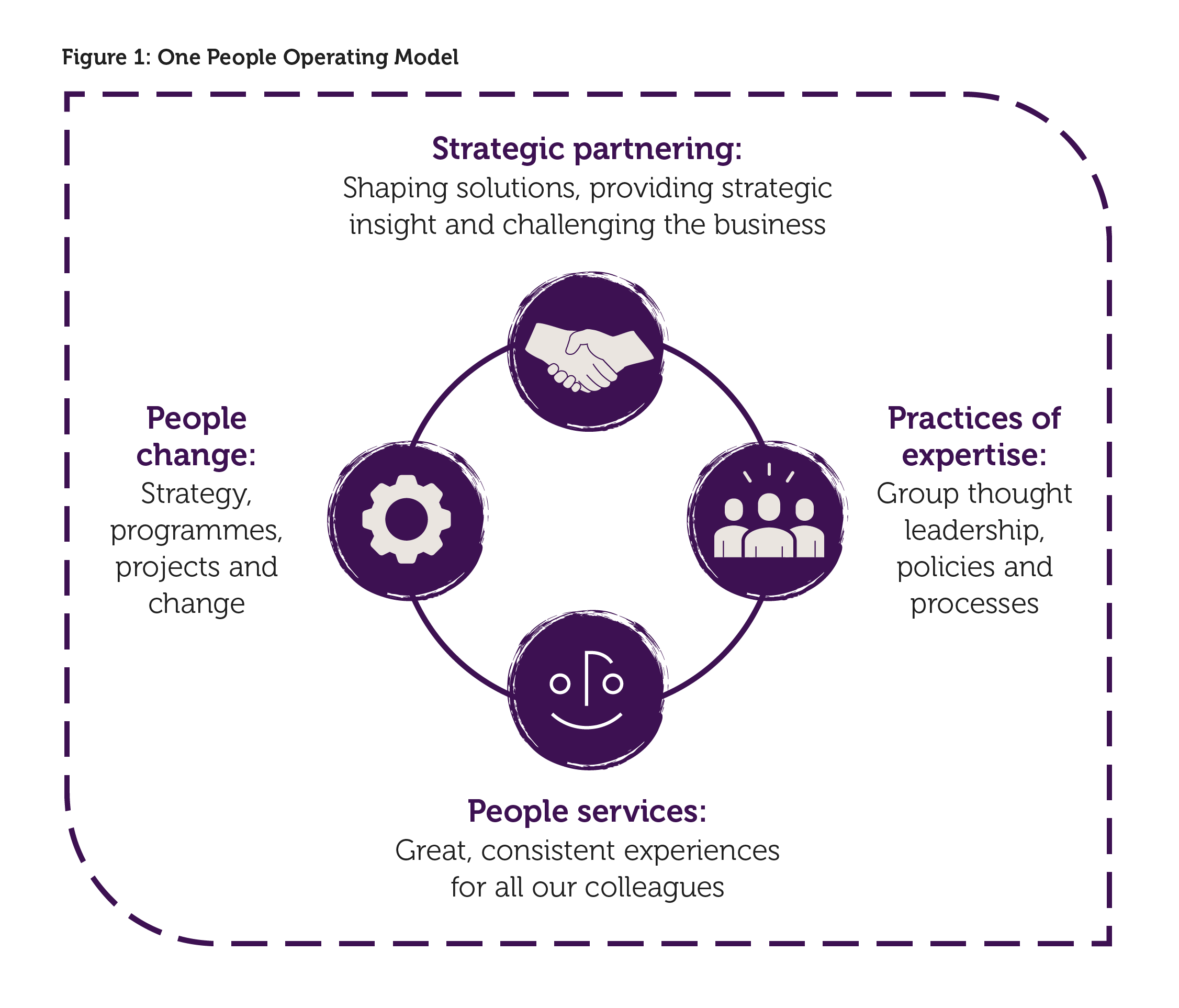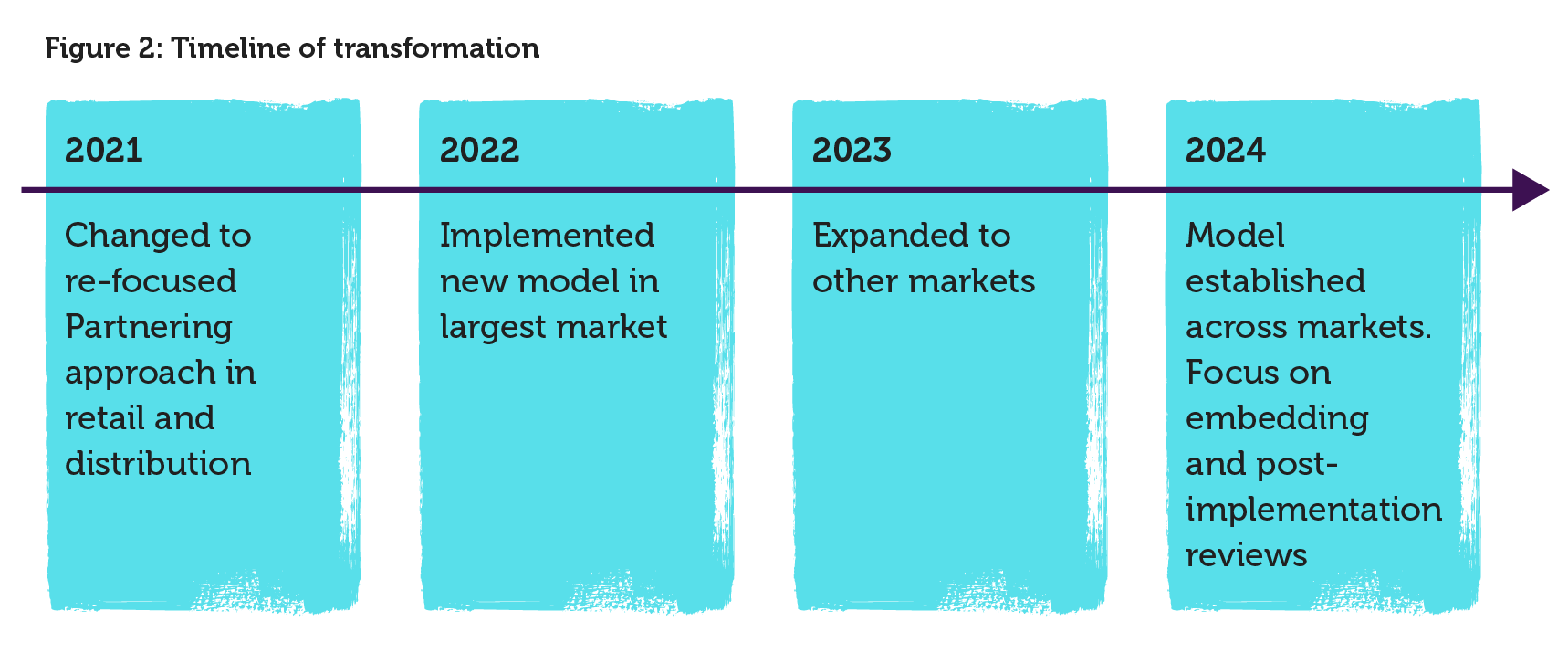Transforming the HR operating model: Tesco
A case study of a people function shifting to a four-pillar model to deliver a more consistent employee experience throughout the organisation

A case study of a people function shifting to a four-pillar model to deliver a more consistent employee experience throughout the organisation

Tesco is a retail, distribution, banking, and mobile communications business operating in the UK, Ireland, Central Europe and India. It has approximately 330,000 employees.
Covering several industries, Tesco has a varied geographical footprint and operates under several brands (including Booker and One Stop). Given the complexity of business operations, Tesco is keen to provide colleagues with a consistent employee experience, regardless of business area. In this case study, employee experience is referred to as ‘colleague experience’, as termed by the organisation.
Eleanor Winder, Head of People Operating Model, explains that colleague experience was a strong driving force for change: “We are working together across Tesco to build a great place to work for all, and colleague experience is at the heart of this. How do we make sure that our colleagues across the business have a consistent experience, no matter where they work?”
Tesco wanted an operating model that enables the business to be future-fit, is responsive to the rapidly changing world of work and provides a consistent colleague experience. This included addressing current workforce needs, while building in more flexibility to respond quickly to changing priorities.
There was a desire to move from a UK-centric model to a more ‘group-led’ approach, which considered the diverse needs of the group, and brought a larger focus on local market requirements.
The HR operating model was designed by the people leadership team using design principles and maturity models to establish the current state and future aspirations of the people function. Tesco applied these design principles across their model to ensure accountability and to measure progress.
Through this change, Tesco aimed to improve the efficiency and impact of the People Team by:
Eleanor Winder stressed that: “The operating model isn’t just the way the team is structured; it’s having one aligned ‘people plan’ and the technology enablement that goes with that. It’s the insight that drives the thinking. It’s the skills that we need in the future.”
The new operating model has four pillars as shown in Figure 1. For the previous Ulrich+ model see McKinsey research for futher details.
 To transform the operating model, the people function made the following changes:
To transform the operating model, the people function made the following changes:
Tesco has taken a staggered approach to introducing and stabilising the model across its markets. The design and development of the new operating model has been iterative (see Figure 2). Tesco recognises that the model will continue to evolve and mature over time in response to changing market and business requirements.

There were several key enablers to ensure the model was implemented and continues to embed effectively:
1. Leveraging internal skills and knowledge within the business: The people function drew on the organisation’s skills and knowledge by partnering with other internal teams, such as the customer insights team. These skills helped the people function to understand colleagues’ sentiment throughout the transformation (for example, what they think and feel about working at Tesco).
2. Developing core skills within the people function: The people leadership team has identified five core skills relevant to all people professionals within the people function. These include:
Each member of the people team has been invited to complete a diagnostic to identify their strength and development areas. Learning programmes are being developed within each of the core skill areas.
3. Understanding and inspiring careers in the new model: To showcase future career opportunities, Tesco produced a podcast-style series of conversations focusing on career pathways in the People Team at Tesco.
4. Developing leaders and new ways of operating: Significant time was spent developing team cohesion and clarifying roles and responsibilities. When the model launched initially, there was a focus on engagement across the business to develop teams’ understanding of the new operating model. Line managers received essential training on talent and learning, and a refresh on self-serve tools, managing resourcing requirements and where to go for HR support.
5. Using ‘Big Room Planning’ to embed the new operating model: This enabled key stakeholders to meet in person and agree priorities for the year ahead. This method of agile planning brings all relevant teams together to align on shared priorities and agree how they will achieve strategic goals on a quarterly basis.
Given the complexity and scale of this transformation, there have been challenges during the process:
To address these challenges, Tesco held workshops to gain insight around deploying the model across different markets. This highlighted the need for a deeper understanding of the Group and key considerations to develop new propositions. As a result, a series of discovery sessions was developed for the people team, to build awareness of the different businesses and geographies across Tesco. More recently, a market toolkit was developed to build more understanding of the nuances, differences and similarities of the different markets in the group.
Eleanor Winder points out: “Our markets have slightly different needs, so we needed to be comfortable that, while we have an ambition, it can't be a ‘one-size-fits-all’ perfect match. We’ve had to find a pragmatic way through to achieve our desired maturity.”
As Tesco is currently embedding the model and running post-implementation reviews, early metrics are being monitored. However, some overall successes of the new model include:
Post-implementation reviews are scheduled six to 12 months after each team change has been implemented. These help celebrate what is working well, but also result in actions such as feedback to colleagues and targeted working groups to facilitate any necessary improvements.
“The world around us, the business, social constructs and technology continue to evolve, so we need to constantly look ahead. There's no sitting back and thinking that we've made it - and that can be challenging in terms of feeling a sense of progress and yet knowing that there's always more to do.” Eleanor Winder, Head of People Operating Model.
Tackling barriers to work today whilst creating inclusive workplaces of tomorrow.

How can people teams balance line managers’ need for operational people management support while growing their team’s strategic influence through the HRBP role?

We look at how investing in digital technologies, HR skills and culture drive success in restructured people functions

A case study of an HR function shifting from an Ulrich+ model towards an employee experience-driven model

We look at the main focus areas and share practical examples from organisations who are optimising their HR operating model

A case study on how Bupa Arabia developed a range of strategic objectives to attract, develop and retain talent

A case study on how Bupa Arabia developed a framework for employee engagement to motivate employees and enhance business performance

A case study on how Aramco introduced an employee engagement initiative as part of its commitment to improve employee experience and wellbeing

A case study of an HR function shifting from an Ulrich+ model towards an employee experience-driven model